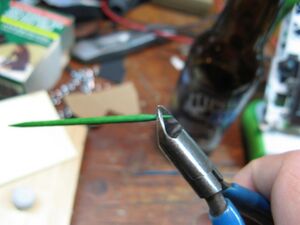D-Pad Toothpick Modification
This improvement was added to the OLPC XO and is in XO-1.5, XO-1.75, and XO-4. --Quozl 02:57, 13 August 2013 (UTC).
Improving the XO laptop's D-pad
The directional pad near the lower left corner of the screen on the XO laptop is somewhat hard to control accurately. For a couple of reasons, it's easy to press too many of the "arrows" at once, and too easy to press multiple times when only one keypress was intended.
Two small changes can improve this behavior quite a bit.
To get access to the D-pad, the bezel surrounding the screen must be removed. Full instructions on disassembling the XO can be found under Disassembly, and you should review that before starting, but to get to the D-pad, only four screws need to be removed. They're under the bottom edge of the screen. Picture #2 shows two of them -- rotate the screen to get at the other two. Be careful -- they're small!
With the screws removed, rotate the antennae up, as in picture #3, slide the side pieces up, and remove them. Then gently lift the bottom edge of the bezel away from the screen, and pull it downward toward the keyboard. It will slide right off.
The D-pad button can then be lifted out of its recess (picture #4).
First Modification
Picture #5 shows the first change. Simply snip or break off the two tiny nubs on either edge of the button. If you look at the back of the screen bezel that you removed, you'll see that these nubs fit into slots in the bezel, and prevent the button from rotating. However, the button is held in other ways, so these nubs aren't really necessary. After snipping off the nubs, sand or scrape the remaining edge to make it smooth.
Why does removing them help? Well, when you push the button down on the left, the right edge wants to rise. When you push on the right, the left edge wants to rise. Similarly, when you push on the top or bottom, the opposite edge wants to rise, but cannot -- these nubs hit the back of the bezel, and keep the button from moving naturally.
Second Modification
This one is a little more work.
The idea is that we want to keep the button from "mashing down" so readily, which is what lets it activate in multiple directions at once. So we want to install a small post in the bottom of the button which will force it to rock back and forth, rather than being able to go straight down. The post I used is just part of a round toothpick.
Start by making a thin hole, just in the rubber part of the button -- not through the hard plastic! A 1/16" drill bit worked for me -- just a little smaller than the 3/32" toothpick (if I recall correctly). I used my drill press, but that's only because once you have a drill press, you feel you need to use it for everything. It also made the picture taking easier.
Snip off some of the pointiest bit from the end of the toothpick, then...
...force the toothpick into the hole you made. Make sure it's in as far as it will go, then snip off most of it, leaving about an 1/8th of an inch.
To make the post the right length, place a piece of sandpaper on your table, and, using a circular motion, sand the stub of toothpick down.
The final length should be just 1mm, or maybe 1.1mm, above the flat surface of the rubber. This will make it perhaps 2 or 3 times as high as the existing little protrusions that are molded into the rubber. Install and try it a few times as you make it shorter. If you screw up and go too far, don't worry -- you still have the other end of the toothpick so you can try again. ;-) (Be sure and install the screen bezel when trying the D-pad -- it makes a big difference to the feel.)
When you think it's right, clean up the button to remove any sawdust, and reassemble the laptop.













